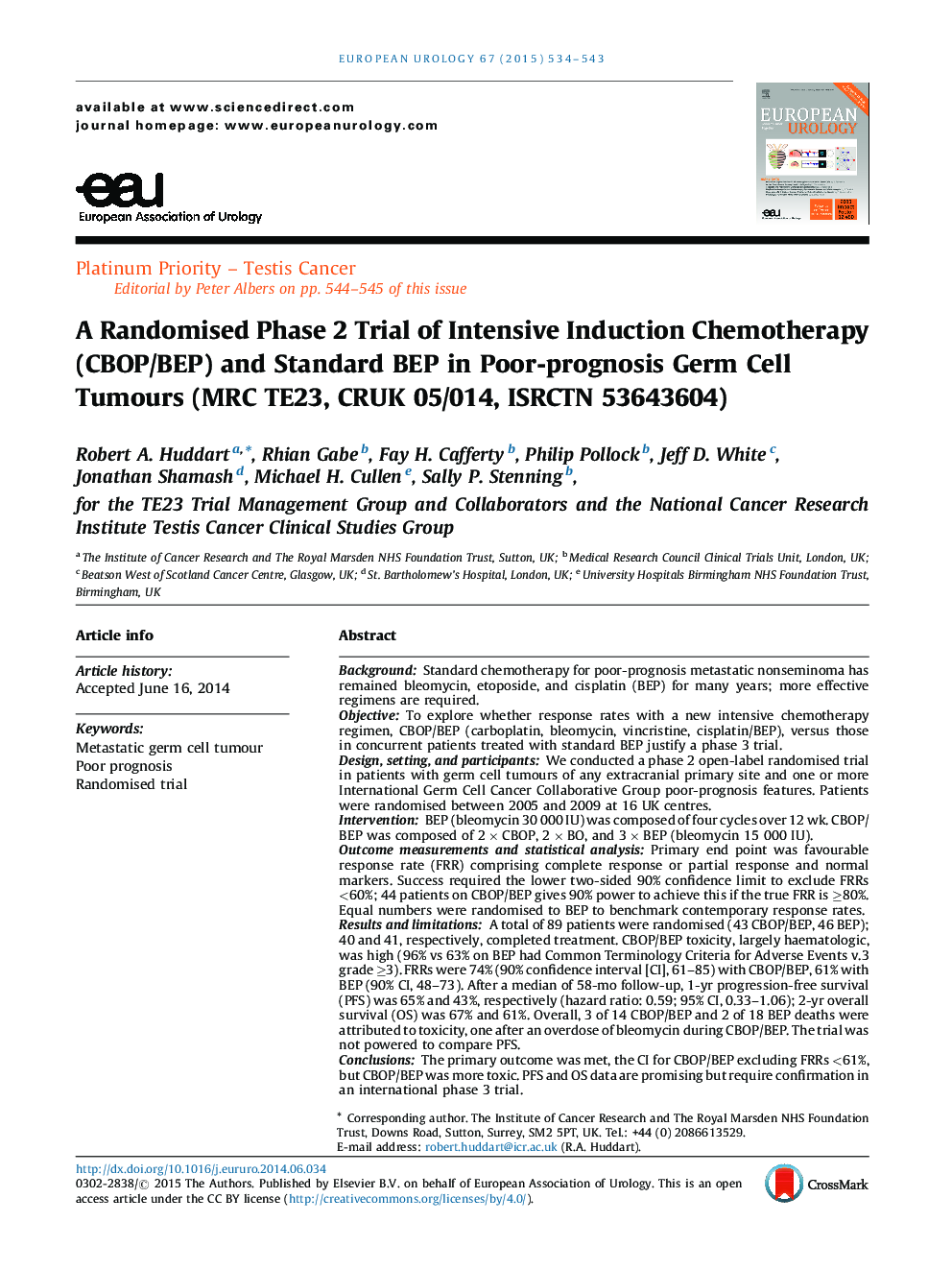| کد مقاله | کد نشریه | سال انتشار | مقاله انگلیسی | نسخه تمام متن |
|---|---|---|---|---|
| 6176736 | 1253060 | 2015 | 10 صفحه PDF | دانلود رایگان |

BackgroundStandard chemotherapy for poor-prognosis metastatic nonseminoma has remained bleomycin, etoposide, and cisplatin (BEP) for many years; more effective regimens are required.ObjectiveTo explore whether response rates with a new intensive chemotherapy regimen, CBOP/BEP (carboplatin, bleomycin, vincristine, cisplatin/BEP), versus those in concurrent patients treated with standard BEP justify a phase 3 trial.Design, setting, and participantsWe conducted a phase 2 open-label randomised trial in patients with germ cell tumours of any extracranial primary site and one or more International Germ Cell Cancer Collaborative Group poor-prognosis features. Patients were randomised between 2005 and 2009 at 16 UK centres.InterventionBEP (bleomycin 30 000 IU) was composed of four cycles over 12 wk. CBOP/BEP was composed of 2 Ã CBOP, 2 Ã BO, and 3 Ã BEP (bleomycin 15 000 IU).Outcome measurements and statistical analysisPrimary end point was favourable response rate (FRR) comprising complete response or partial response and normal markers. Success required the lower two-sided 90% confidence limit to exclude FRRs <60%; 44 patients on CBOP/BEP gives 90% power to achieve this if the true FRR is â¥80%. Equal numbers were randomised to BEP to benchmark contemporary response rates.Results and limitationsA total of 89 patients were randomised (43 CBOP/BEP, 46 BEP); 40 and 41, respectively, completed treatment. CBOP/BEP toxicity, largely haematologic, was high (96% vs 63% on BEP had Common Terminology Criteria for Adverse Events v.3 grade â¥3). FRRs were 74% (90% confidence interval [CI], 61-85) with CBOP/BEP, 61% with BEP (90% CI, 48-73). After a median of 58-mo follow-up, 1-yr progression-free survival (PFS) was 65% and 43%, respectively (hazard ratio: 0.59; 95% CI, 0.33-1.06); 2-yr overall survival (OS) was 67% and 61%. Overall, 3 of 14 CBOP/BEP and 2 of 18 BEP deaths were attributed to toxicity, one after an overdose of bleomycin during CBOP/BEP. The trial was not powered to compare PFS.ConclusionsThe primary outcome was met, the CI for CBOP/BEP excluding FRRs <61%, but CBOP/BEP was more toxic. PFS and OS data are promising but require confirmation in an international phase 3 trial.Patient summaryIn this study we tested a new, more intensive way to deliver a combination of drugs often used to treat men with testicular cancer. We found that response rates were higher but that the CBOP/BEP regimen caused more short-term toxicity. Because most patients are diagnosed when their cancer is less advanced, it took twice as long to complete the trial as expected. Although we plan to carry out a larger trial, we will need international collaboration.Trial registrationISRCTN53643604; http://www.controlled-trials.com/ISRCTN53643604.
Journal: European Urology - Volume 67, Issue 3, March 2015, Pages 534-543